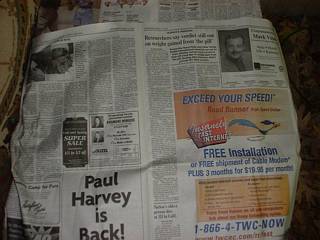 |
Start by preparing a clean surface where you will be laying
down the
carbs. Paul Harvey does not need to be back. |
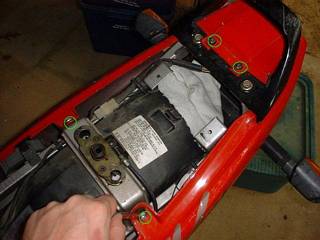 |
Remove the seat and then the two bolts and two screws circled
in the
green that hold the plastic side covers. |
 |
Remove tail plastic bit. I swear that the previous owner did
those
scratches on the handle :-). |
 |
Pop out the covers and remove them. |
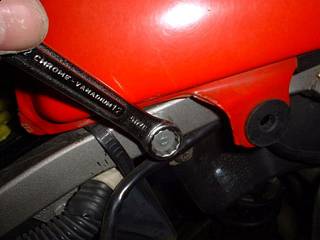 |
Remove the two tank bolts. |
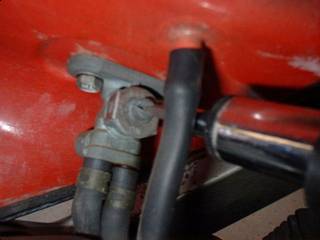 |
From the right side, move tank backwards and lift a little.
Turn petcock
screw horizontal to close it. If you disconnect the overflow hose in
front
first it's easier to reach it. |
 |
Disconnect negative pole of the battery. |
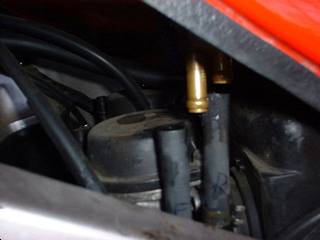 |
Clearly mark the fuel hoses and disconnect them at the
petcock. Disconnect
also the overflow hose from the middle of the tank. Have some rugs to
catch
up spills of gas. |
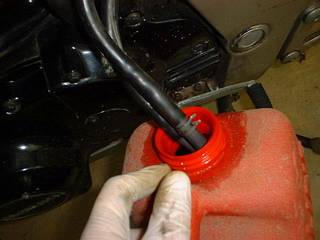 |
Empty the two hoses in a gas tank. Yeah, possibly a cleaner
one than
mine. |
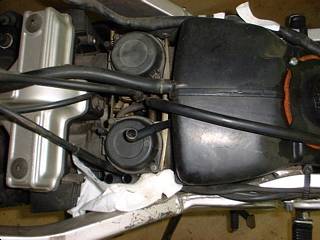 |
Pull the tank back and lift it to remove it. This is how it
looks.
Take note of how all the hoses are routed. Make a diagram if necessary. |
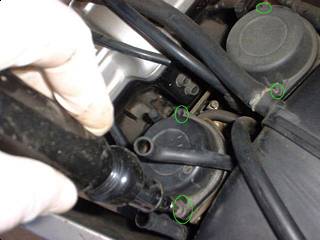 |
If you just want to shim the needles, you don't need to
remove the
carbs form the bike. One carb at a time, remove screws holding
diaphragm
caps. |
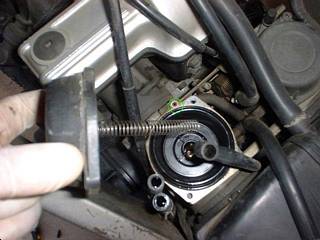 |
Carefully remove cap. Don't loose the o-ring marked in green. |
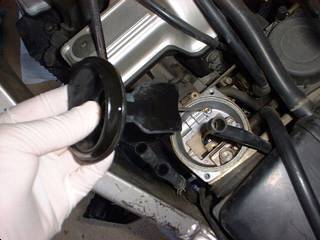 |
Remove slide. Hold your thumb on the hole to keep the needle
from dropping
out. |
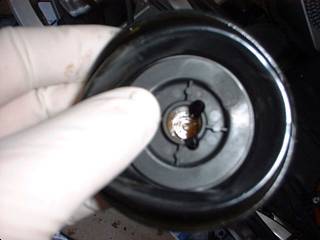 |
See the top of the needle at the bottom of the hole?
Carefully turn
the slide upside down and the needle will drop out. Don't loose any of
the plastic spacers. |
 |
Insert one or two #4 stainless steel washers btw the C-clip
and the
plastic doughnut. Put needles back in place and insert slide back into
the carb. Close cap making sure that the diaphragm is in the grove. You
can use the cap without spring to push it into the grove, then replace
cap again with spring, and close. |
 |
Now on to rejetting... These are the new jets, 127.5 mains
and 40 pilots.
I got the pilots from the local stealer for $6.50 each (!!) and the
mains
from Chaparral for $2.30 each. Main jets Mikuni part number is N100/604
(don't know why the label says 601 instead.)
Nonbleeding type pilots, Mikuni part N151.067, are hard to find.
According
to JeffD, bleeding type are ok too. |
 |
Let's take off airbox and carb. Start by releasing the cabs
overflow
hose on the right and wire harness on the left of the airbox. |
 |
Disconnect valve cover breather hose from airbox. |
 |
Remove two screws holding airbox, one per side. |
 |
Unbolt fuel valve and leave it hanging outside the frame. |
 |
Disconnect drain hose from under the airbox. You can leave it
there
and pull it out, but make sure you know where it's routed. |
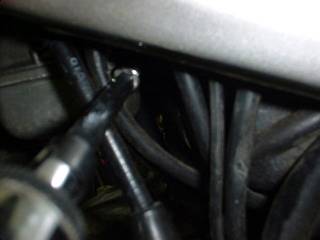 |
Loosen the clamps holding the air intake to the carbs. In my
case,
one of the screw heads was stripped off, so I had to pull out carbs and
airbox together. If you can remove the airbox first it makes the job
easier. |
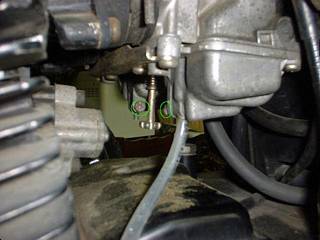 |
Fit a hose to the drain nipple and run it into a tank. Open
drain screw
and let gas flow out. |
 |
Same thing on the other side. |
 |
Loosen up clamps to the engine intakes. One per carb. |
 |
Disconnect choke cable. Pull back, left end out. |
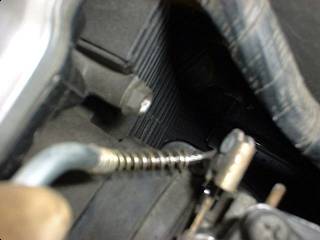 |
|
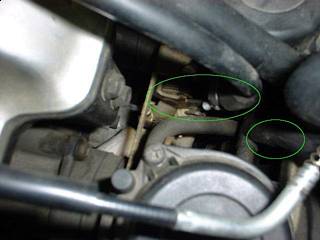 |
Disconnect throttle cable and the fuel hose from the lower T. |
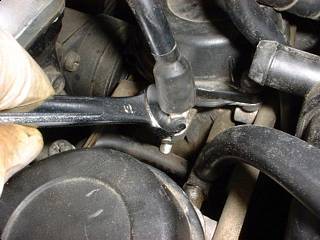 |
To disconnect the throttle cable, loosen up upper bolt,
unscrew lower
bolts completely, push cable from below and remove. |
 |
Disconnect fuel valve vacuum hose from left carb. |
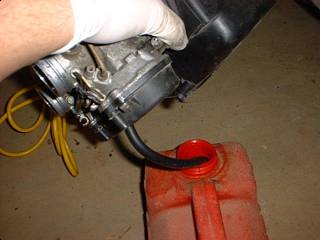 |
Now everything is disconnected.
Take the carb assembly, turn it upside-down, and empty the
remaining
gas from the upper overflow hose into the gas tank, and not on your
legs
like I did.
|
 |
My carbs were all dirty outside, so I closed all openings
with pieces
of plastic bags and rubber bands, and cleaned the gunk with a
toothbrush
soaked in WD-40 , followed by dish soap to remove any residual grease,
and rinsed them with water.
Finally, I dried them out with a hair drier.
|
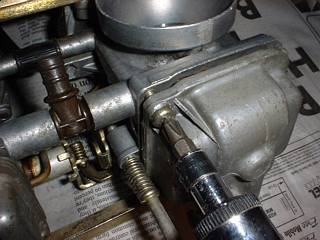 |
Open the bowls, two screws each. Someone had been there
already and
stripped one head. |
 |
Ouch! Rust! Back to the cleaning department! Note that I
removed the
gasket that goes into the grove near the edge. |
 |
If you want to clean it with carburetor cleaner, remove all
plastic
bits and rubber o-rings. I used carburetor cleaner followed by dish
soap. |
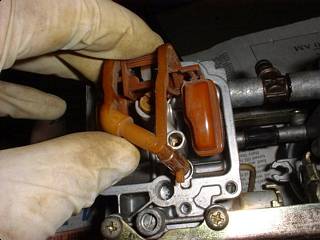 |
Wasn't this supposed to be white?! |
 |
While I was at it, I opened up the upper part again, and
cleaned up
there too. Don't loose the little o-ring near Paul. |
 |
Remove main jets. and replace with new ones. You may have to
clean
the seat. |
 |
See how shiny and clean it is now?
Remove the pilot jets. Use the widest flat head screw driver that fits
into the hole. The jet are made of brass and it's easy to strip the
head
if they are seized. Guess how I know?
Time to put things back together now.
Install new jets in place of old mains and pilots. Close bowls
(don't
forget the gasket.)
In green is the pilot air screw. If it hasn't been touched
before, it is covered by a brass plug that needs to be taken out. This
is a good time to do it. Carefully drill a hole in the plug, insert a a
drywall screw and pull it out. Mine was already uncovered.
|
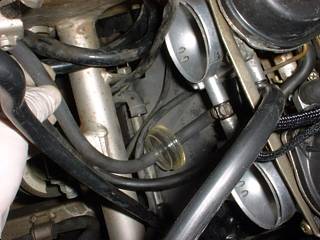 |
Put the carbs back into the frame, but leave them
disconnected from
the engine intakes. Install choke and throttle cables, fuel valve
vacuum
hose into the left carb, lower T fuel hose. Move all hoses out of the
way
to make room for the airbox.
I installed an inline fuel filter splicing the line the goes
to the
lower T. You can see it on the left.
|
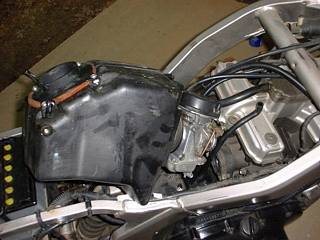 |
Connect the airbox to the carbs and close the clamps a little
so that
the boots won't slip off, but loose enough to allow some adjustment. |
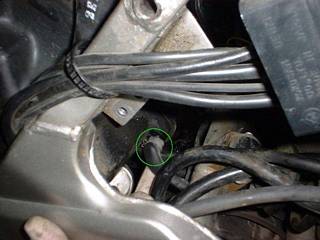 |
Connect airbox drain hose at the bottom of the airbox. |
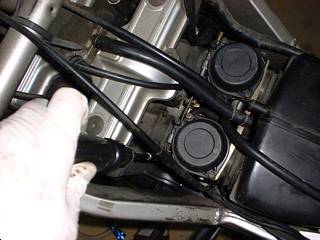 |
Push carbs into engine intake boots and close clamps tightly.
Make
sure not to pinch fuel hoses under the airbox. I pinched the valve
vacuum
hose which got disconnected from the fuel valve. After assembling
everything,
I spent half an hour trying to understand why there was no fuel going
to
the engine. |
 |
Close clamps btw airbox and carbs. |
 |
Close clamps holding wire harness and overflow hose. |
 |
Reattach all hoses to fuel valve. This is the vacuum hose
that got disconnected when dropping the airbox into the frame.
Reattach the fuel valve to frame, and connect the two fuel
lines to the tank. First connect the rear one and put the clamp on,
then connect the front one and put the clamp on. It's nearly impossible
to put the clamps on if you do the other way around.
Don't forget to turn the petcock valve back to the open
position, and connect the tank breather hose to the center of the
tank.
Reinstall the fuel tank and the side covers.
Leave the fuel valve on PRIME for a few second, then turn on
the engine and let it warm up to operating temperature.
|
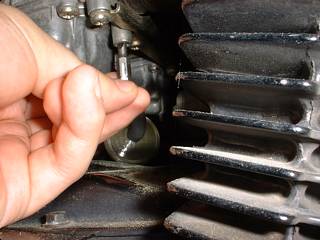 |
The last thing you need to do is to adjust the pilot air
screws. There
are two, one per each carb. I used a flat head drill bit and marked one
side with white-out to see easily how many turns I was doing.
I followed this procedure to set the pilot air screws.
- Close both screws taking note of what the current setting
are. Open them at 1 tunr out.
- Warm up engine and turn the choke off.
- Lower the idle to below 1000rpm
- Open the air screw up to the point where the engine revs
don't increase anymore. Then open 1/4 of a turn more.
- Lower the idle again to below 1000 rpm
- Blip the throttle to 1/4. If the rpms dip before rising,
you are too rich. If the rpms hang up and come back slow to idle,
you're lean.
- Set the idle back to normal, i.e. 1200 rpms.
At the end, I set it at 3 turns out.
You're done!!! Enjoy the much improved power curve!
|